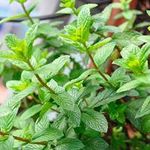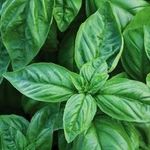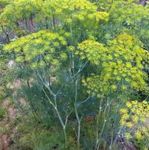Houston Herb Garden 2020 - Sam Houston Memorial Museum
←
→
Page content transcription
If your browser does not render page correctly, please read the page content below
1
Houston Herb Garden
2020
Aloe Vera Aloe Vera is a succulent perennial plant. It may be used
on skin conditions or superficial cuts for its antimicrobial
and antioxidant properties. It is also consumed to help
with constipation and other internal ailments.
Artemisia Artemisia is also known as wormwood. Several kinds of
Artemisia are used in herbal medicine and many are
cultivated for their feathery gray foliage. It has a very mild
fresh scent but a bitter taste and was sometimes put in the
cabinet to give the linens a fresh smell.
Asparagus is low calorie, low in sodium with no
Asparagus cholesterol as well. It is also a rich source of dietary
fiber, which is essential for the body. Its tender
shoots are a great source of vitamins, minerals, and
essential proteins.
Purple basil has a striking dark burgundy color. The
flavor is not as sweet as some basil varieties with a
Basil – Purple
stronger clove taste. Highly aromatic, purple basil can
be steeped in vinegar or oil to add beautiful color to
one’s dishes.
Basil is a warm-weather annual herb, which is very
Basil – Sweet
fragrant and tastes great in tomato-based dishes,
Italian seasonings and the beloved pesto.
Basil –
Bell Pepper Basil is an excellent culinary variety useful
Bell Pepper in any dish where a bell pepper flavor is desired.
Withstands cold better than many other varieties and
can be overwintered indoors with plenty of light.
Pretty spikes of maroon/pink flowers add interest to
the herb garden.2
Chamomile Chamomile blossoms steeped to make tea has been used in
alternative medicine as possibly an effective aid in treating
anxiety, upset stomach, colic, diarrhea and insomnia
Chives have a mild onion flavor and contains a considerable
Chives amount of vitamin C, potassium and folic acid. They are a
good addition to modern recipes to restore vital nutrients
that are lost in cooking. Medicinally, they are known to
promote good digestion and comfort stomach upset.
The cilantro leaves are often used in Asian and Latin
Cilantro/ American cooking and have a lively citrusy taste. Coriander
Coriander is the dried seed of the cilantro plant. The seeds are used in
curries, curry powder, pickles, sausages, soups, and stews. It
can stimulate insulin secretion as well as lower cholesterol
and blood sugar levels.
Curry Tree The curry tree is found mostly in countries with hot
climates and is a native plant of India. The leaves of the
curry tree are called curry leaves or sweet neem leaves and
are a common spice in Indian cuisine.
Dill is an annual herb in the celery family and has been
Dill widely used since ancient times. Its leaves and seeds are
used as an herb or spice for flavoring food especially
pickling and cold salads.
Echinacea is a group of flowering plants used as a popular
Echinacea herbal remedy. They are linked to many health benefits,
such as reduced inflammation, improved immunity and
lower blood sugar levels. Echinacea plants are loaded with
plant compounds that function as antioxidants.3
Eggplant Eggplant is a flowering plant that belongs to the
nightshade family. Most commonly purple, the spongy,
absorbent fruit is used in several cuisines. Typically used as
a vegetable in cooking, it is a berry by botanical definition.
Ginger is a flowering plant, whose rhizome, ginger root
Ginger
or ginger, is widely used as a spice and in folk
medicines. The health benefits of honey and ginger in
treating respiratory problems are unmatched by any
other concoction.
Fennel is a perennial herb of the carrot family grown for
Fennel its edible shoots, leaves, and seeds. It is a highly aromatic
and flavorful culinary herb and, along with the similar-
tasting anise, is one of the primary ingredients of absinthe.
Black Spanish Grapes are a delicious sweet and juicy
Grapes – seeded grape that produces large clusters of small to
Spanish Black medium size grapes. This variety is a heavy and
consistent producer. This is an older variety from back in
the 1800s.
Lavender is a flowering plant in the mint family that’s easily
Lavender identified by its sweet floral scent and has been around
since ancient times. Lavender is good for clearing the mind,
body and soul, as well as, lavender helps support a calm
composure and reduces irritability, apprehension, stress,
nervous tension, insomnia, nightmares, and is generally
balancing to the psyche.
Lemon balm is an herb in the mint family. It is often used
Lemon Balm for culinary purposes to make teas, marinate chicken or
fish, or flavor baked foods and jams.4
This fragrant beauty, lemon verbena, will maintain a tidy
Lemon size. In the ground, it forms a luxuriously lemony shrub.
Verbena Packed with delicious citrus flavor, thinly sliced leaves add
zest and aroma to fish, salads, and steamed vegetables.
Marigold, also known as calendula, is traditionally used to
help relieve minor burns, wounds and other skin problems.
Marigolds The flower petals may be utilized as an herbal infusion,
topical solution and eyewash. Marigold petals add color and
flavor in various dishes like stews, soups, pudding and
salads. It is an excellent companion plant because it repels
harmful insects such as aphids and whiteflies. Its petals are
used as a natural dye.
Marjoram is a somewhat cold-sensitive perennial herb or
under-shrub with sweet pine and citrus flavors. People
Marjoram make medicine from marjoram’s flowers, leaves, and oil to
treat many ailments such as asthma, menstrual cramps,
coughs, colds, liver problems, gallstones, headache, and
diabetes.
Mint has been long identified in diverse cultures, such as
India, Middle East and Europe, due to its abundant aroma,
calming taste and healing qualities. There are 30 species of
Mint – Julip mint and hundreds of varieties. Its characteristic smell
makes it one of the most well-liked perfuming herbs. NOT
to be confused with mint julep, which is an alcoholic
beverage.
This mint is very sweet smelling and a favorite for
Mint –
taste and healing properties such as settling an upset
Spearmint stomach.
Mullein tea made from the flowers and leaf, is a beneficial
remedy for bronchitis, sore throat, tonsillitis, dry coughs,
and hoarseness. The large whole leaves were also used for
Mullein bandages because of its softness and because of its anti-
inflammatory properties. It is a biennial plant.
Nasturtium flowers are aromatic with a fragrance
reminiscent of mustard and have a tender, mild, peppery,
and slightly spicy taste. Both the flowers and leaves of the
Nasturtium nasturtium plant are edible and have a peppery taste, like a
watercress. Both the buds and seeds of the nasturtium
plant are edible and are commonly pickled yielding a flavor
and texture like capers.5
Onions are full of antioxidants and help support the
Bunching Onions immune system, so they are one of the healthiest foods
one can eat. The bulbs are small but are very flavorful when
chopped and added to any culinary dish.
Oregano is widely used as a spice. It has an aromatic, warm,
Oregano and slightly bitter taste. It has been used around the
Mediterranean region for centuries. Oregano and other
herbs provide antioxidants and promote good health.
Italian parsley is a variety of the parsley plant used as an
herb in a wide range of cuisines around the world. The flat
Parsley-Italian
leaves taste robust and fresh and can be added whole or
chopped. It is commonly used to elevate the flavor of
dishes like soups, salads and fish recipes.
Pepper – The cayenne pepper is a berry, not a vegetable. It is a
digestive stimulant, a cardiovascular tonic and a first aid
Cayenne
application for bleeding. It’s also high in iron and vitamins
A,C,E and K. It can be very spicy eaten fresh or dried.
Pepper – Marconi peppers have a sweet and mild taste. They grow
Marconi to be rather large. This makes them great for roasting with
your favorite stuffing mix.
Purslane is a small, fleshy or succulent, annual ground cover
Purslane plant. Its flowers and leaves are edible and are a rich source
of potassium, magnesium and calcium. It adapts well to dry
areas with poor soil and grows like a weed.
Rosemary is part of the mint family, as is basil,
Rosemary
lavendar, oregano, and many other herbs. It is a
woody, perennial shrub with fragrant, evergreen,
needle-like leaves and white, pink, purple, or blue
flowers, and native to the Mediterranean region.6
Rue has been cultivated since ancient times as a small
Rue garden shrub for its evergreen leaves and dull-yellow flower
clusters. The oils in the stems and leaves can be irritating to
sensitive skin especially when skin is exposed to sunlight,
and can result in photo-sensitivity or contact dermatitis. Care
must be taken when handling rue. It is toxic when
consumed in large quantities. Medicinal benefits include its
digestive, relaxing and antispasmodic properties.
Sage Sage is a perennial plant and cultivated for its pungent leaves.
It is native to the Mediterranean
It region and is used fresh or
dried as a flavoring in many foods, particularly in stuffing for
poultry, pork and in sausages.
Spiderwort plants are perennial herbs. The roots are a
Spiderwort laxative. They are also used as a tea in the treatment of
kidney and stomach ailments and women's complaints. A
poultice of the leaves can be applied to stings, insect bites
and cancers.
The health benefits of strawberries include improved eye
care, proper brain function, relief from high blood pressure,
Strawberries arthritis, gout, and various cardiovascular diseases.
Surprisingly, strawberries are not a fruit, but rather a fleshy
receptacle for the seeds, which is the actual fruit.
Thyme is a pungent, perennial, evergreen, culinary herb
Thyme
widely used in French and Italian cuisines. It is a relative to
oregano and has medicinal and ornamental uses as well. In
ancient Egypt is was used for embalming.
Another popular variety of thyme for culinary purposes.
Medicinally, thyme is taken by mouth for bronchitis,
Thyme –
whooping cough, sore throat, colic, arthritis, upset stomach,
Mother of Thyme stomach pain, diarrhea, intestinal gas, parasitic worm
infections and skin disorders. It is also a diuretic and an
appetite stimulant.
The fleshy fruit of tomatoes are the major dietary source of
Tomatoes the antioxidant lycopene, which has been linked to many
health benefits, including reduced risk of heart disease and
cancer.7
The Vicks plant, is a rare succulent perennial, cascading
Vicks Plant
herb. It is named for its relaxing methanol fragrance
synonymous with the vapor rub. Vicks' bright green velvety
foliage has a minty, menthol aroma, and when crushed can
be inhaled (or steamed) to clear congestion.
Wild violets are edible perennial plants that spread both by
Wild Violets rhizomes and by seeds. Violet flowers and leaves are edible
with the leaves having a high level of vitamins A and C. They
can be used in salads or cooked as greens. The flowers can
be made into jellies, candied, or tossed into a salad.
Medicinally it is used as a remedy for coughs and sore
throat, hoarseness and tonsillitis.
Zinnias
Zinnias are grown as a long lasting cut flower to be enjoyed
in an arrangement or to add color to the garden. It is a very
drought tolerant plant best grown in southern USA and
Mexico.
Zucchini Zucchini is a summer squash. It is a nutritious low-calorie
heart healthy food that contains good amounts of
potassium, which helps reduce blood pressure. It is also
rich in minerals and vitamins.
Compiled By Jude’ Lee Routh, Exhibits CuratorYou can also read



























































